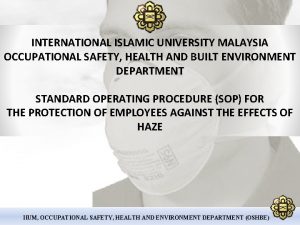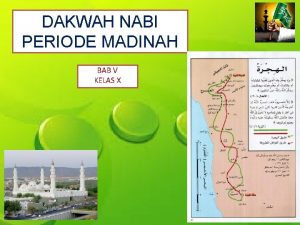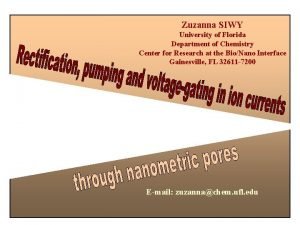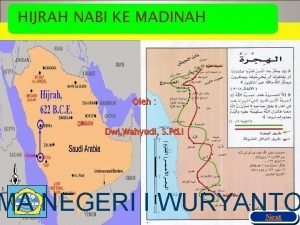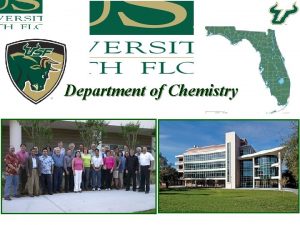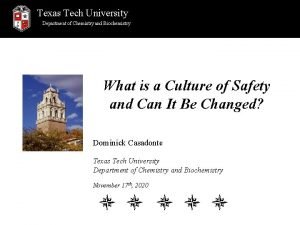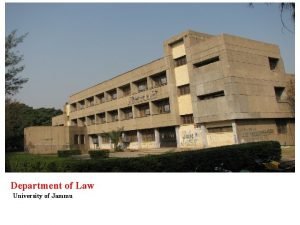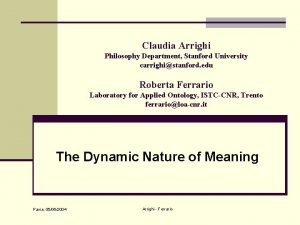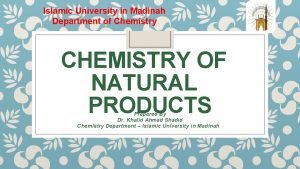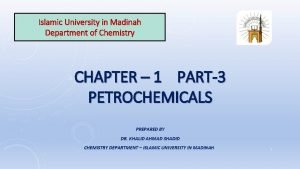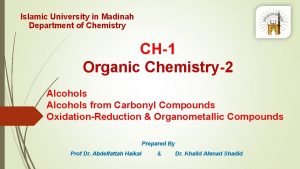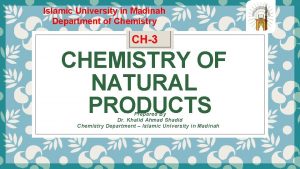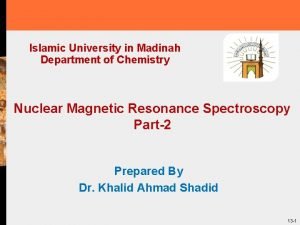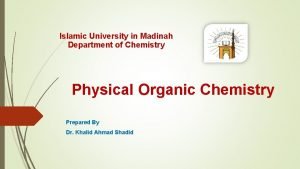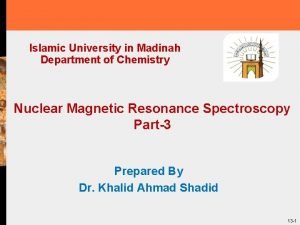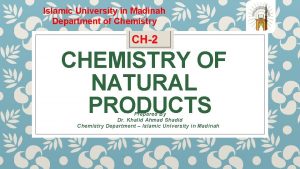Islamic University in Madinah Department of Chemistry CHAPTER








































- Slides: 40

Islamic University in Madinah Department of Chemistry CHAPTER – 1 PART-2 PROCESSES IN THE OIL REFINERY PREPARED BY DR. KHALID AHMAD SHADID CHEMISTRY DEPARTMENT – ISLAMIC UNIVERSITY IN MADINAH 1

CRACKING • Crude oil is separated into its different components by a process called fractional distillation. • The products of fractional distillation are often converted into other, even more useful hydrocarbons by a process called cracking. • Although all of the fractions produced from crude oil have their uses, some of the fractions are produced in greater quantities than needed, whilst others are not produced in sufficient quantities. • Petrol and naphtha approximate supply% are much less than approximate demand% 2

CRACKING • This can be corrected by breaking up some larger hydrocarbons in fuel oil into the smaller ones found in gas oil, or by breaking up some hydrocarbons in kerosene into the smaller ones found in petrol, naphtha or the liquefied petroleum gases. In other words the larger fractions (for which supply exceeds demand) can be broken up into smaller fractions (for which demand exceeds supply). The process by which this is carried out is called cracking. 3

CRACKING • cracking is important for two reasons: i) It converts low-demand fractions into higher demand fractions ii) It makes useful hydrocarbons not naturally found in crude oil • There are two types of cracking: thermal cracking and catalytic cracking. Both involve the breaking of C-C bonds to form smaller molecules. C-C bonds are weaker than C-H bonds and so break more easily when heated. 4

THERMAL CRACKING • In thermal cracking, the bonds are broken using a high temperature (400 – 900 o. C) and a high pressure (70 atmospheres). The high temperatures mean that the molecule breaks near the end of the chain, giving a high percentage of small alkenes such as ethene. • Most thermal cracking reactions involve the formation of one of more small alkane molecules and one alkene molecule. Naphtha (C 7 – C 14) is usually used as the starting material. 5

THE FREE-RADICAL CHAIN REACTION • Initiation: Generates a radical intermediate. • Propagation: The intermediate reacts with a stable molecule to produce another reactive intermediate (and a product molecule). • Termination: Side reactions that destroy the reactive intermediate. 6

RADICAL MECHANISM REACTIONS OF ETHANE • Radical mechanism pyrolysis of hydrocarbons can be subdivided into three phases: • Initiation: Homolytic Fission • Propagation Steps: 7

RADICAL MECHANISM REACTIONS OF ETHANE • • Termination 8

RADICAL MECHANISM REACTIONS OF PROPANE • Initiation: • Propagation Steps: 9

RADICAL MECHANISM REACTIONS OF PROPANE • Beta fission C-C in propyl radical to produce ethylene with methyl free radical • While C-H fission in isopropyl radical takeover to produce propene with hydrogen radical 10

RADICAL MECHANISM REACTIONS OF PROPANE • • Termination 11

RADICAL MECHANISM REACTIONS OF NAPHTHA • Initiation: Homolytic fission in heating • Propagation Steps: Beta fissions to form ethylene molecules 12

RADICAL MECHANISM REACTIONS OF NAPHTHA • Fragmentation process in propagation steps: • H removal from main alkane by methyl free radical which formed from previous steps to form nonyl free radical and methane • H removal from main alkane by ethyl free radical which formed from previous steps to form nonyl free radical and ethane with ethylene • H radical removes hydrogen atom from main molecule 13

RADICAL MECHANISM REACTIONS OF NAPHTHA Beta -fissions to form ethylene molecules 14

RADICAL MECHANISM REACTIONS OF BRANCHED ALKANES • Butene but not ethylene are formed 15

RADICAL MECHANISM REACTIONS OF CYCLIC ALKANES • Butadiene formation 16 In aromatic compounds: Thermal cracking only occurs with the side chain of hydrocarbon, not with aromatic ring

CATALYTIC CRACKING • Catalytic cracking, including fluidic catalytic cracking, are processes in which a chemical catalyst is used to increase the yield of thermal cracking process. Acidic catalyst like Aluminum silicate or zeolite catalyst added to the feed stock stream allows the breakdown of long chain molecules into lighter, short chain hydrocarbon molecules at temperature 460 -520 o. C, and a slight pressure (slightly greater than 1 atmosphere). • The aim of catalytic cracking is: • 1. to increase gasoline by converting Heavy fuel and fuel oil into gasoline. • 2. to produce better quality of gasoline and octane number of gasoline • 3. To produce some important chemicals like: propene, butene, and hydrocarbon gases. 17

MECHANISM REACTIONS OF CATALYTIC CRACKING • Feed stock of Heavy fuel and fuel oil contain high complicated mixture of chemicals. Hence its difficult to study the path of chemical reactions. • In describing main reactions which is lead to decrease in molecular weight for feed stock. • Mechanism of catalytic cracking: • 1. Primary reactions • 2. Secondary reactions 18

MECHANISM REACTIONS OF CATALYTIC CRACKING • 1. Primary reactions: formation of carbonium ion (intermediate). • 2. Secondary reactions: (Rearrangement, dehydrogenation), producing aromatic compounds from hydrocarbon chains … etc. • Primary reactions: • 1. Primary reactions: 1. Primary reactions from alkane chain like Hexadecane (C 16 H 34) carbonium ion can form from: • A) an alkene which formed from thermal cracking, then protonation of alkene by catalyst to form carbonium ion 19

MECHANISM REACTIONS OF CATALYTIC CRACKING • B) from dehydration of Hydride ion H¯ of alkane through catalyst • C) the carbonium ion subtract Hydride anions of methylene groups in main alkane. Hence more stable secondary carbonium ions formed. • D) Fission of carbonium ion in adjacent bond, this called Beta fission: • Fission of Hexadecane carbonium ion to from Heptene with primary carbonium ion 20

MECHANISM REACTIONS OF CATALYTIC CRACKING • Fission catalytic for branched alkane chains and cyclic alkanes, also catalytic fission if aromatic hydrocarbon substituted with two or more alkyl groups • Mechanism of Fission include protonation of aromatic ring to produce sigma complex sigma ( ), which undergoes to further fission to give carbonium ion and benzene. Carbonium ion will lose proton to form an alkene • This type of production has high octane number (good quality of fuel). • The main production is Ethylene, Benzene and branched alkenes. 21

MECHANISM REACTIONS OF CATALYTIC CRACKING • 2. Secondary reactions • The primary reaction in catalytic cracking undergoes for Structural Conversions: • 1. shifting of double bond in alkenes into middle of chain. Then a branched alkene will be more stable with high octane number. (Protonation of double bond followed by elimination of a proton from adjacent carbon of carbonium ion) • 2. further breaking on alkenes that formed in primary reactions through protonation of alkenes to form carbonium ions, then formation of a small molecules of alkenes and alkanes. 22

MECHANISM REACTIONS OF CATALYTIC CRACKING • 3. conversion of cycloalkanes (cyclohexanes) into alkenes and aromatic hydrocarbons by a series reactions of deprotonation. 23

MECHANISM REACTIONS OF CATALYTIC CRACKING • 4. Formation of an aromatic hydrocarbons from alkenes cyclic chains • Main production from secondary reactions of catalytic cracking is Benzene, Toluene, Xylenes, and small alkenes like ethylene. 24

MECHANISM REACTIONS OF CATALYTIC ALKYLATION • Catalytic Alkylation is the reaction of isobutane with alkenes to form higher branched alkanes (“alkylate”). • The aim is the production of gasoline components with a high octane number from low molecular weight alkenes (propene, butenes, and pentenes) and isobutane. • The advantages of catalytic alkylation are that gas-phase molecules are eliminated and a valuable liquid product is formed, that is, gasoline with high octane number (87 up to 98). 25

MECHANISM REACTIONS OF CATALYTIC ALKYLATION Normally acid catalyzed using H 2 SO 4 or anhydrous HF. 38% 16% 4% 25% 26

MECHANISM REACTIONS OF CATALYTIC ALKYLATION Initiation Step: Protonation of propene by a catalyst following by subtracting hydride ion H¯ of Isobutane by carbonium ion of propene. The alkylation of Tertiary Carbonium ion of butyl react with a propene to form secondary carbonium ion of dimethyl pentyl 27

MECHANISM REACTIONS OF CATALYTIC ALKYLATION Propagation Steps: The secondary carbonium ion of dimethyl pentyl undergoes to series of rearrangements reactions through shifting of 2, 1 Hydride ion or methyl group and the formation of carbonium ions, while more stable carboinum ion will dominate 28

MECHANISM REACTIONS OF CATALYTIC ALKYLATION Subtracting of Hydride ion from isobutene by secondary methyl pentyl carbonium ion to form a branched alkane with a tertiary butyl carbonium ion. Propagation Steps: Tertiary butyl carbonium ion react with propene and then a series of reactions will take over. 29

MECHANISM REACTIONS OF CATALYTIC ALKYLATION Side reactions of catalytic Alkylation operation: 1. A proton shifting from a tertiary butyl carbonium ion into propene molecule to form isobutene molecule 2. Reaction of the formed isobutene above with tertiary butyl carbonium ion to give tertiary carbonium ion of 8 carbon atoms. 30

MECHANISM REACTIONS OF CATALYTIC ALKYLATION 3. Tertiary carbonium ion of 8 carbon atoms subtracting hydride ion, from isobutane to give a branched alkane of 8 carbon atoms, and hence another tertiary carbonium ion will form. 4. The 2 nd and 3 rd steps will regenerate. 31 Final product of catalytic alkylation is a branched side chain of alkanes.

MECHANISM REACTIONS OF CATALYTIC REFORMING • Catalytic reforming is a key process in the production of gasoline components with a high octane number. It also plays an important role in the production of aromatics for the chemical industry. Furthermore, catalytic reforming is a major source of hydrogen. • Feedstocks are straight-run naphtha and other feeds in the gasoline boiling range (about C 6 –C 11). • During catalytic reforming the change in molecular weight of the feed is relatively small, as the process mainly involves internal rearrangement of hydrocarbons. • Reactions of Catalytic Reforming 1) Dehydrogenation of cyclic hexanes to form Aromatic compounds 32

MECHANISM REACTIONS OF CATALYTIC REFORMING • Reactions of Catalytic Reforming 2) Reaction of Dehydrogenation with formation of cyclopentanes which substituted to form aromatic compounds. (Dehydroisomerisation). 3) Rearrangement of alkanes (Isomerisation) 33

MECHANISM REACTIONS OF CATALYTIC REFORMING • Reactions of Catalytic Reforming 4) Dehydrocyclization of alkane to form aromatic compounds. 4) Hydrocracking Reaction 34 Hydrocarbon with less than 6 carbon atoms can not converted to aromatic compounds.

MECHANISM REACTIONS OF CATALYTIC REFORMING Mechanisms: 1. Dehydrogenation of cyclic hexanes to form Aromatic compounds: Done in seconds on surface catalyst which is difficult to study the mechanism 2. Dehydrogenation with forming: 1. Dehydrogenation on surface of catalyst on site of hydration 2. Formation of substituted cyclopentene 3. Protonation and carbonium ion formation. 1. Rearrangement followed by cyclisation on the surface of cidic catalyst. 2. Formation carbonium ion of cyclohexyl 3. Proton Subtractin and Conversion into cyclohexene 35 1. Dehydrogenation on surface of catalyst on site of hydration

MECHANISM REACTIONS OF CATALYTIC REFORMING Mechanisms: 3. Rearrangement of alkanes (Isomerisation)/ Rearrangement on two sites of catalyst 1. Dehydrogenation of alkane on site of hydration 2. Protonation of alkene formed on acidic site of catalyst. 3. Formation of carbonium ion. 1. Rearrangement of carbonium ion, followed by subtracting of proton. 2. Formation of isomer of above alkene. 36 1. Hydration of alkene to form an alkane isomer with above alkane.

MECHANISM REACTIONS OF CATALYTIC REFORMING 4. Dehydrocyclization (Aromatization) of alkane to form aromatic compounds. • Metal clusters of Pt incorporated into the channels of zeolite L have been found to catalyze the dehydrocyclization of heptane with a high activity and selectivity. • Reaction temperature=750 K, H 2/n-alkane molar ratio=6 and atmospheric pressure Mechanisms: 1. Bond formation due to Dehydrogenation of alkane with a surface od catalyst. While all other Carbon in a gases form. 2. Cyclisation of alkene by a combination of one of carbon bond with a carbon in a gases form (dehydration). 3. A continuing dehydration of alkene to form an aromatic hydrocarbon. 37

STEAM REFORMING The term steam reforming is used to describe the reaction of hydrocarbons with steam in the presence of a catalyst. • This process used to synthesis a synthetic gas to prepare Ammonia and methanol, and also used as a source of hydrogen gas, which is used in hydrogenation processes. • The process used to rearrange alkanes containing C 1 to C 4, particularly methane. • The process is also used, for the preparation of synthesis gas from naphtha. the process involves, hydrocarbon gas and water vapor to pass, on the catalyst surface. • Basic interaction of the process of steam reforming of methane molecule, for example: 38

STEAM REFORMING Formation of carbon Carbon formation in steam reformers must be prevented for two main reasons. Firstly, coke deposition on the active sites of the catalyst leads to deactivation. Secondly, carbon deposits grow so large that they can cause total blockage of the reformer tubes, resulting in the development of “hot spots”. Hence, the reforming conditions must be chosen such that carbon formation is strictly limited. 39

THANK YOU 40
 Peta konsep strategi dakwah rasulullah di mekkah
Peta konsep strategi dakwah rasulullah di mekkah Manipal university chemistry department
Manipal university chemistry department Oshbe
Oshbe Islamic university college
Islamic university college Cara dakwah rasulullah di mekah
Cara dakwah rasulullah di mekah Isi piagam madinah
Isi piagam madinah Dakwah rasulullah di madinah berlangsung selama
Dakwah rasulullah di madinah berlangsung selama Nasheed madina
Nasheed madina Apa tujuan nabi ekspansi dakwah ke luar kota madinah
Apa tujuan nabi ekspansi dakwah ke luar kota madinah Membangun masyarakat madinah
Membangun masyarakat madinah Siwy madinah
Siwy madinah Dawateislami istikhara bradford
Dawateislami istikhara bradford Madinah
Madinah Peta hijrah nabi
Peta hijrah nabi Ringkasan piagam madinah
Ringkasan piagam madinah Kerajaan islam di madinah
Kerajaan islam di madinah Usf chemistry department
Usf chemistry department Nit calicut chemistry
Nit calicut chemistry Ttu chemistry department
Ttu chemistry department Chapter 19 islamic gunpowder empires
Chapter 19 islamic gunpowder empires Chapter 9 lesson 2 the arab empire and the caliphates
Chapter 9 lesson 2 the arab empire and the caliphates Chapter 27 the islamic empires
Chapter 27 the islamic empires Chapter 27 the islamic empires
Chapter 27 the islamic empires Ib chemistry organic chemistry
Ib chemistry organic chemistry Inorganic chemistry vs organic chemistry
Inorganic chemistry vs organic chemistry Department of law university of jammu
Department of law university of jammu Department of geology university of dhaka
Department of geology university of dhaka University of padova psychology department
University of padova psychology department University of bridgeport it department
University of bridgeport it department University of iowa math department
University of iowa math department Sputonik
Sputonik Psychology texas state
Psychology texas state Department of information engineering university of padova
Department of information engineering university of padova Information engineering padova
Information engineering padova Syracuse university psychology department
Syracuse university psychology department Jackson state university finance department
Jackson state university finance department Computer science department columbia
Computer science department columbia Michigan state university astronomy
Michigan state university astronomy Columbia university cs department
Columbia university cs department University of sargodha engineering department
University of sargodha engineering department Stanford university philosophy department
Stanford university philosophy department


